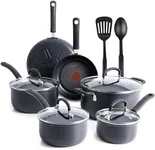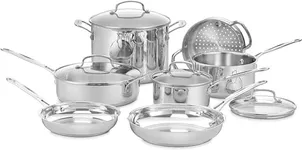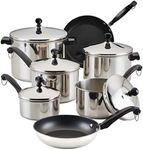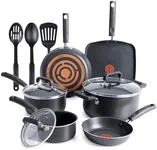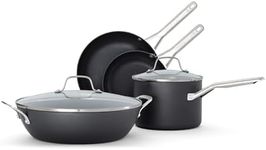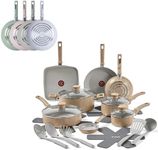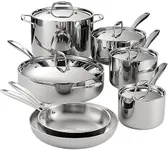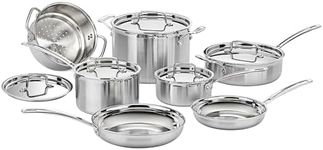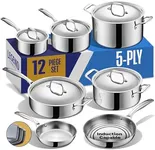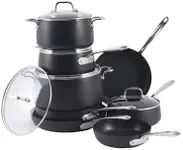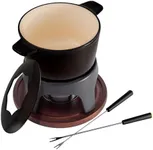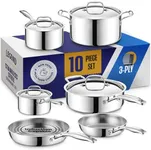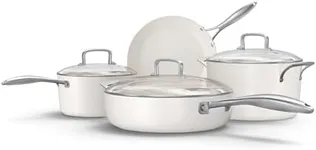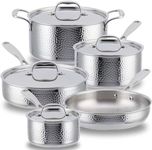Buying Guide for the Best Kitchen Cookware Sets
Choosing the right kitchen cookware set can significantly enhance your cooking experience. The right set will not only make cooking more enjoyable but also ensure that your food is cooked evenly and efficiently. When selecting a cookware set, it's important to consider various factors such as material, heat conductivity, durability, and ease of maintenance. Understanding these key specifications will help you make an informed decision that best suits your cooking needs and preferences.MaterialThe material of the cookware affects its heat conductivity, durability, and maintenance. Common materials include stainless steel, non-stick, cast iron, and copper. Stainless steel is durable and resistant to rust and staining, making it a good all-around choice. Non-stick cookware is great for low-fat cooking and easy cleanup but may not be as durable. Cast iron retains heat well and is excellent for slow cooking, but it requires more maintenance. Copper offers excellent heat conductivity but can be expensive and requires regular polishing. Choose a material based on your cooking habits and how much maintenance you're willing to perform.
Heat ConductivityHeat conductivity refers to how evenly and quickly the cookware heats up. Materials like copper and aluminum are excellent conductors of heat, ensuring even cooking and reducing hot spots. Stainless steel, while durable, is not as good at conducting heat unless it has an aluminum or copper core. If you often cook dishes that require precise temperature control, such as sauces or delicate proteins, prioritize cookware with high heat conductivity.
DurabilityDurability is about how long the cookware will last and how well it can withstand regular use. Stainless steel and cast iron are known for their durability and can last for many years if properly cared for. Non-stick coatings can wear off over time, especially if metal utensils are used. Consider how often you cook and the types of utensils you use when evaluating durability. If you want a long-lasting set, opt for materials known for their resilience.
Ease of MaintenanceEase of maintenance includes how easy the cookware is to clean and care for. Non-stick cookware is generally the easiest to clean, but it requires careful handling to avoid damaging the coating. Stainless steel can be more challenging to clean if food sticks to it, but it is dishwasher safe and can handle abrasive cleaning. Cast iron requires seasoning and careful cleaning to prevent rust. Choose cookware that fits your willingness to maintain it and your cleaning preferences.
Number of PiecesCookware sets come with varying numbers of pieces, typically ranging from 5 to 15 or more. A basic set usually includes essential items like a frying pan, saucepan, and stockpot. Larger sets may include additional pieces like sauté pans, steamer inserts, and more. Consider the types of dishes you frequently cook and the number of pieces you actually need. If you have limited storage space, a smaller set with versatile pieces may be more practical.
Compatibility with CooktopsNot all cookware is compatible with every type of cooktop. For example, induction cooktops require cookware with a magnetic base, such as certain stainless steel or cast iron pieces. Gas and electric cooktops are more versatile, but it's still important to check compatibility. If you have an induction cooktop, ensure that the cookware set you choose is labeled as induction-compatible. This will ensure efficient cooking and prevent damage to your cooktop.
Oven SafetyOven safety refers to the maximum temperature the cookware can withstand in the oven. This is important if you plan to use your cookware for recipes that require transferring from the stovetop to the oven. Materials like stainless steel and cast iron are generally oven-safe at high temperatures, while non-stick cookware may have lower temperature limits. Check the manufacturer's guidelines for oven safety to ensure the cookware meets your cooking needs.
Handles and LidsHandles and lids affect the usability and safety of the cookware. Look for handles that are securely attached and made of heat-resistant materials to prevent burns. Some handles are designed to stay cool on the stovetop, which can be a useful feature. Lids should fit snugly to retain moisture and heat. Glass lids allow you to monitor cooking without lifting the lid, but they can be more fragile. Consider your cooking style and preferences when evaluating handles and lids.
